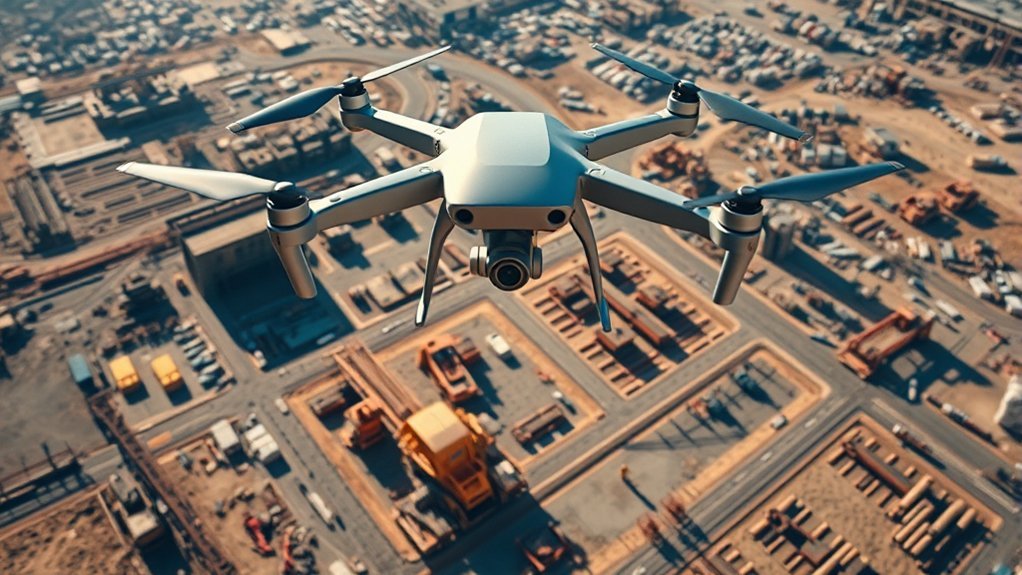In the world of construction mapping, precision often clashes with performance. You need a drone that can deliver both, ensuring accurate data collection while maneuvering through challenging conditions. The right choice can transform your project outcomes. So, which drones stand out in this competitive landscape? Let’s explore the top five options that can elevate your construction mapping efforts.
GPS Drone with 4K Camera for Beginners
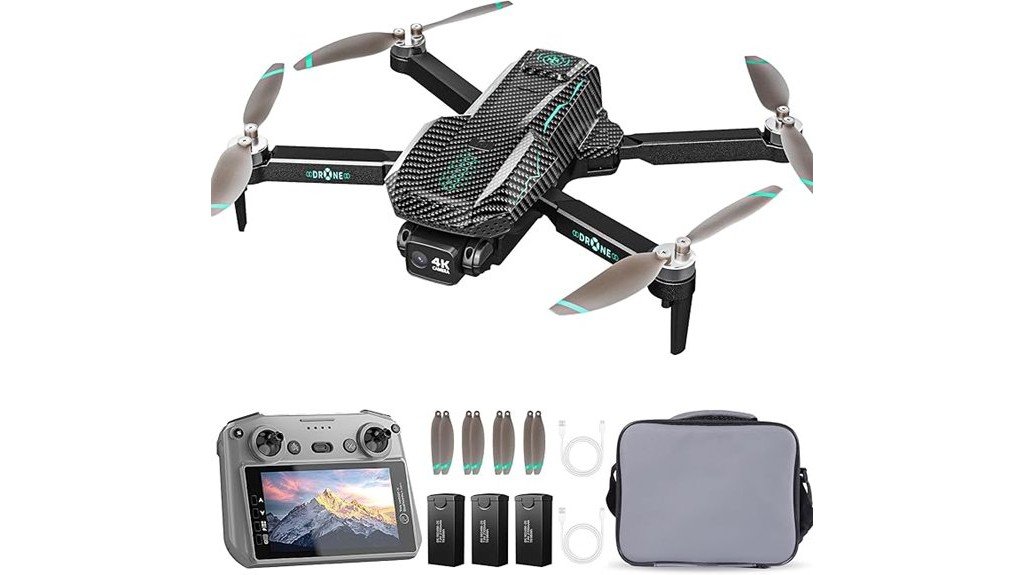
If you’re a beginner looking to immerse yourself in construction mapping, the GPS drone with a 4K camera is a fantastic choice. With its 4K HD camera and 90° adjustable angle, you can capture stunning photos and videos. The live footage appears on a 5-inch LCD screen, so you won’t need to fuss with apps. This drone’s intelligent GPS guarantees precision flight up to 400ft, while the Auto Return-to-Home feature keeps it safe. Plus, with three high-capacity batteries, you get 90 minutes of flight time. Lightweight and portable, it’s perfect for outdoor adventures and easy to control, making it user-friendly for anyone.
Best For: Beginners and hobbyists interested in aerial photography and outdoor adventures.
Pros:
- 4K HD camera with adjustable angle for high-quality photos and videos.
- User-friendly controls with one-key takeoff/landing and adjustable speed settings.
- Lightweight and portable design, including a protective case for easy transport.
Cons:
- Limited control range of 2000ft may not satisfy advanced users.
- Battery life, while decent, may require frequent recharging for extended use.
- Brushless motor performance could be less effective in very high wind conditions.
Sky High Bulls-Eye Drone Ground Control Point (6 Pack)
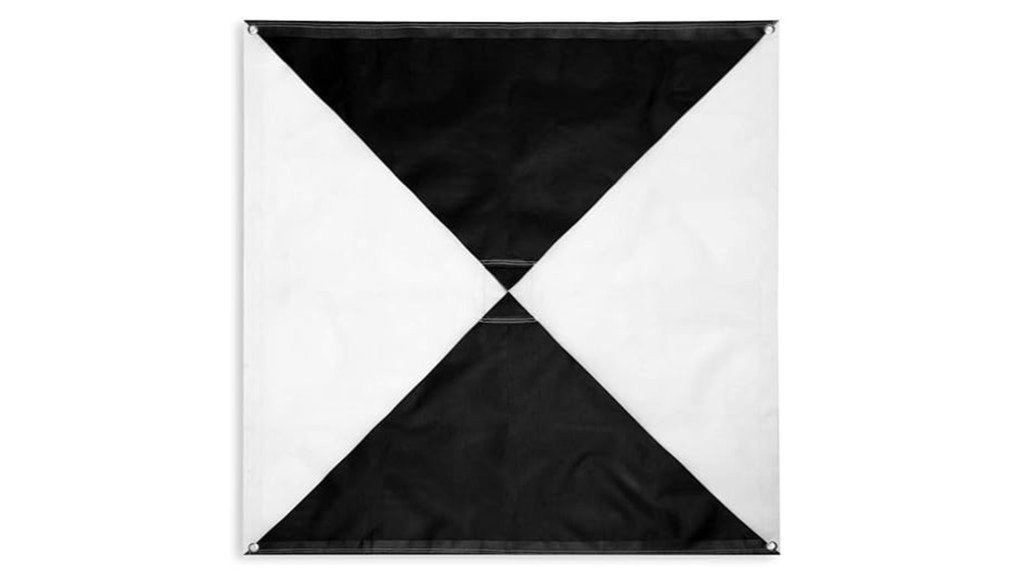
The Sky High Bulls-Eye Drone Ground Control Point (6 Pack) is an essential tool for construction professionals and surveyors looking to enhance the accuracy of their aerial mapping projects. Designed for low to medium altitude drone mapping, these lightweight, weatherproof targets feature a center passthrough design for easy placement over existing markers. The corner anchor points help secure them, preventing movement during flights. Plus, they’re compatible with most photogrammetry software, ensuring reliable data collection. By using these GCPs, you’ll improve both the precision and efficiency of your mapping efforts, making them a vital addition to your toolkit.
Best For: Construction professionals and surveyors seeking to enhance accuracy in aerial mapping projects.
Pros:
- Lightweight and durable design, made from weatherproof mesh material.
- Compatible with various photogrammetry software for reliable data collection.
- Easy placement and secure anchoring to prevent movement during flights.
Cons:
- Limited to low to medium altitude drone mapping (up to 400 feet).
- Requires existing markers or stakes for optimal use.
- May not be suitable for high-precision applications without additional calibration.
N11 PRO GPS Drone with Camera for Adults
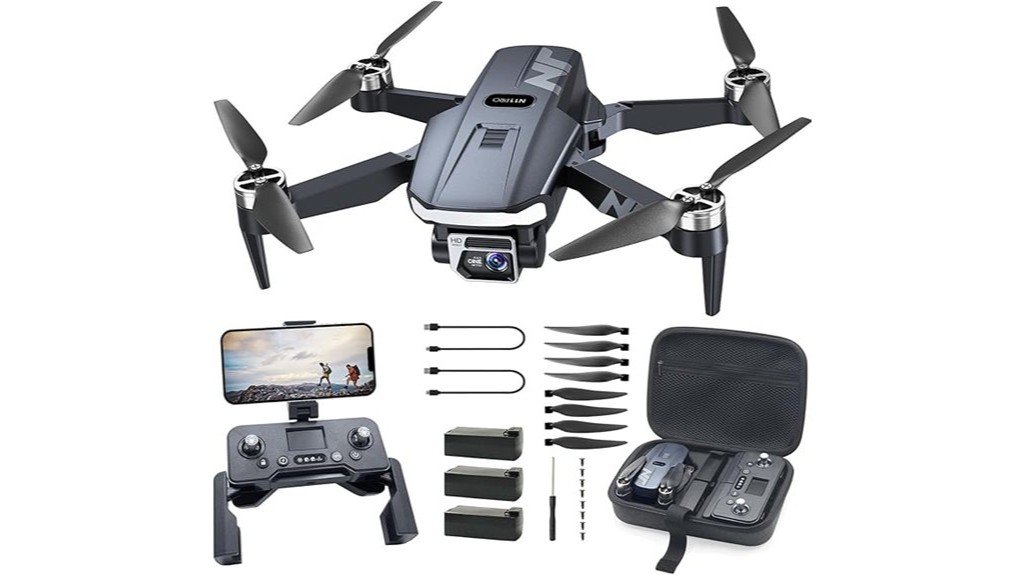
Designed for adults venturing into construction mapping, the N11 PRO GPS Drone stands out with its impressive flight time of up to 90 minutes, thanks to its three included batteries. Weighing under 0.55lb, you won’t need FAA registration, making it hassle-free to operate. With a control range of 3,328 feet and a 4K UHD camera, you’ll capture stunning aerial imagery. Its brushless motors provide stability, while GPS and Optical Flow enhance positioning. Enjoy intelligent flight features like Follow Me and Tap Fly, though be aware of mixed reviews on Wi-Fi reliability. Overall, it’s a solid choice for beginners in construction mapping.
Best For: The N11 PRO GPS Drone is best for adults looking for an easy-to-use drone for construction mapping and aerial photography without the hassle of FAA registration.
Pros:
- Impressive flight time of up to 90 minutes with three batteries included.
- User-friendly controls make it suitable for beginners.
- Durable design that withstands minor crashes and impacts.
Cons:
- Mixed reviews on Wi-Fi reliability, potentially affecting camera access at distance.
- Some users have expressed disappointment with the auto-return feature.
- Video quality may not meet professional standards for advanced users.
Drone with Camera for Adults, 2K HD FPV Drones
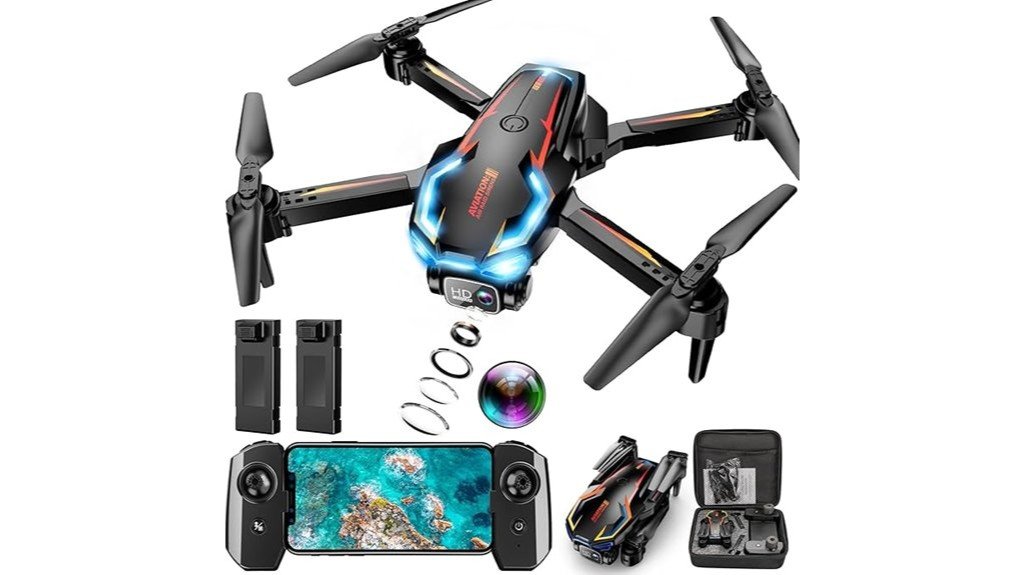
For adults seeking an efficient tool for construction mapping, the Loiley Drone stands out with its impressive 2K Ultra HD camera. With a weight under 250g, you won’t need FAA registration, making it hassle-free. The drone features a 90° adjustable camera angle, providing real-time panoramic views via a wireless connection to your smartphone. Enjoy a total flight time of approximately 26 minutes thanks to its two rechargeable batteries. Plus, user-friendly operations like one-key takeoff and gravity sensing make controlling it intuitive. With propeller guards for safety and 24-hour support, this drone is a perfect companion for your mapping needs.
Best For: Adults seeking a lightweight and efficient drone for construction mapping and aerial photography.
Pros:
- High-Quality Imaging: 2K Ultra HD camera with a 90° adjustable angle for capturing stunning aerial views.
- User-Friendly Features: One-key takeoff/landing and gravity sensing make it easy to operate for beginners.
- Safety Measures: Equipped with propeller guards and overvoltage protection for enhanced safety during flights.
Cons:
- Limited Flight Time: Total flight time of approximately 26 minutes may require frequent battery changes for extended use.
- Weight Limitations: Being lightweight (under 250g) may affect stability in windy conditions.
- Smartphone Dependency: Requires a smartphone for real-time panoramic views, which may not be ideal for all users.
Kids Drone with 3D Flip and Altitude-Hold

Looking for a fun and engaging way to introduce kids aged 6-12 to flying drones? The Kids Drone with 3D Flip and Altitude-Hold is perfect! It features user-friendly controls like one-click take-off and headless mode, making it easy for beginners. With cool lighting effects and 3D flips, kids will love the excitement it brings. Built from durable ABS material, it’s safe for indoor use, protecting little ones and pets. Plus, it comes with two rechargeable batteries, giving you 18 minutes of flight time. With its compact design and engaging features, this drone is an excellent choice for young aviators.
Best For: Kids aged 6-12 looking for a safe and fun introduction to flying drones.
Pros:
- User-friendly controls with one-click take-off and headless mode simplify operation for beginners.
- Durable ABS material and full-protection design ensure safety during indoor use.
- Includes two rechargeable batteries for a total of 18 minutes of flight time.
Cons:
- Flight time of 9 minutes per battery may not be long enough for extended play.
- Limited to indoor use due to its size and propeller design.
- May require parental supervision for younger children to ensure safe operation.
Factors to Consider When Choosing a Drone for Construction Mapping
When choosing a drone for construction mapping, you need to take into account several key factors. Camera quality plays an essential role in capturing detailed images, while flight time impacts how much area you can cover efficiently. Don’t forget to evaluate control range, GPS accuracy, and GCP compatibility to guarantee your mapping projects go smoothly.
Camera Quality Importance
While choosing a drone for construction mapping, camera quality plays an essential role in guaranteeing accurate results. High-resolution cameras, like 4K UHD, deliver detailed imagery vital for precise mapping and surveying. This clarity aids in better analysis and informed decision-making for your projects. Additionally, having the ability to adjust camera angles, such as 90° or 100°, enhances your versatility in capturing various perspectives of the site. Real-time live video transmission allows for immediate assessments, streamlining on-the-spot decision-making. A wide field of view, achieved through adjustable lenses, enables extensive coverage of large areas, increasing efficiency. Finally, confirm compatibility with photogrammetry software for seamless integration of your images into mapping applications, facilitating accurate modeling and analysis.
Flight Time Considerations
Camera quality is just one aspect to contemplate in your drone selection process. You’ll want to prioritize flight time, especially if you’re mapping large construction sites. Look for drones with flight times exceeding 30 minutes, which reduces the need for frequent battery changes. Drones equipped with multiple high-capacity batteries can provide cumulative flight times of up to 90 minutes, enhancing your efficiency. Additionally, consider the auto return feature; it guarantees your drone returns safely when battery levels are low, preventing data loss. Finally, flight stability is key. Drones with brushless motors can handle moderate winds, maintaining stable operation for accurate mapping. Choosing wisely here can save you time and improve your overall mapping results.
Control Range Evaluation
Choosing the right drone for construction mapping involves evaluating several key factors, with control range being paramount. A control range of at least 2000 feet is recommended, allowing you to cover larger areas without losing signal. Drones with extended ranges, like up to 3328 feet, offer more flexibility when surveying expansive sites. Keep in mind that a limited range can restrict your ability to capture thorough aerial data. Longer control ranges also help you maintain a clear view of the drone while maneuvering around obstacles typical in construction environments. Additionally, consider the drone’s signal strength and potential interference factors, as they can greatly impact its effective control range during operation.
GPS Accuracy Features
When it comes to construction mapping, GPS accuracy features play an essential role in ensuring precise data collection. Look for drones equipped with Intelligent GPS systems that enhance flight precision and allow mapping at altitudes up to 400 feet. It’s vital to choose drones with Auto Return-to-Home (RTH) features, which automatically bring the drone back when the battery is low or the signal is lost, maintaining your data integrity. Drones utilizing dual positioning systems, like Optical Flow and GPS, provide stable flight capabilities that improve mapping accuracy both indoors and outdoors. Finally, evaluate the drone’s compatibility with popular photogrammetry software to effectively process mapping data and achieve high-accuracy results.
GCP Compatibility Necessity
Accurate construction mapping relies not only on GPS features but also on the effective use of Ground Control Points (GCPs). These essential tools enhance the accuracy of the aerial data your drone collects, ensuring reliable measurements and analysis. When choosing a drone, you should look for compatibility with popular photogrammetry software, as this allows for seamless integration into your mapping workflow. Additionally, GCPs equipped with corner anchor points help secure them during flights, preventing movement that could compromise data quality. Their standard size and design make them versatile for low to medium altitude drone mapping, ensuring you can effectively carry out construction surveying projects with confidence. Don’t underestimate the importance of GCPs in achieving precise construction planning and execution.
Durability for Outdoor Use
While considering a drone for construction mapping, durability is a key factor that can’t be overlooked. You’ll want a drone made from robust materials like weatherproof mesh or crash-resistant ABS to handle harsh outdoor conditions. A lightweight yet sturdy design is essential for enduring wind resistance while guaranteeing stable flights for accurate data collection. Opt for drones equipped with brushless motors, offering better wind resistance and quieter operation—ideal for mapping tasks. Additionally, a reliable anchoring mechanism on ground control points (GCPs) is vital for securing your mapping targets and preventing any movement during data collection. Finally, confirm your drone maintains high stability in various weather conditions, including light winds, to achieve precise mapping and surveying results.
Software Integration Options
Choosing the right drone for construction mapping isn’t just about the hardware; software integration plays an essential role in guaranteeing efficient data processing and accuracy. Start by checking if the drone is compatible with popular photogrammetry software, as this will streamline your workflow. Look for models that support auto-detection of ground control points (GCPs), which simplifies integration with mapping software. Confirm the drone can fly at the required altitude—typically up to 400 feet—for your surveying needs. It’s also beneficial to select drones that allow easy anchoring of GCPs, maintaining accuracy across multiple flights. Finally, verify compatibility with both industry-standard tools and educational programs to maximize versatility for various construction projects.
User-Friendly Controls
When it comes to construction mapping, having user-friendly controls in your drone can make all the difference, especially for those new to aerial surveying. Drones with features like one-key takeoff and landing simplify operations, letting you focus more on data capture instead of flying mechanics. Adjustable speed settings help you adapt to varying conditions, enhancing both safety and control throughout your mapping tasks. Intuitive functions such as auto-return and altitude-hold provide stability, ensuring your drone returns safely and reducing the risk of loss or damage. Additionally, clear instructional guides or QR codes for pre-flight calibration can greatly boost your confidence and efficiency, making it easier to learn and master your drone quickly.
Frequently Asked Questions
How Do Drones Improve Accuracy in Construction Mapping?
Drones act like modern-day surveyors, soaring above the site to gather precise data. They capture high-resolution images and create detailed maps, ensuring you make informed decisions, streamline planning, and boost overall project accuracy.
What Is the Average Flight Time for Construction Drones?
Most construction drones have an average flight time of 20 to 30 minutes. Depending on the model and battery capacity, you can maximize efficiency by scheduling your flights and planning battery swaps strategically.
Can Drones Be Used in Adverse Weather Conditions?
Yes, drones can be used in adverse weather conditions, but their performance may be affected. You should always check manufacturer specifications and avoid flying in severe rain, high winds, or low visibility to guarantee safety and accuracy.
What Software Is Needed for Drone Mapping Data Processing?
“Don’t put all your eggs in one basket.” For drone mapping, you’ll need software like Pix4D, DroneDeploy, or Agisoft Metashape to process your data effectively, ensuring accurate, high-quality results for your projects.
Are There Any Legal Restrictions for Using Drones in Construction?
Yes, there are legal restrictions for using drones in construction. You need to comply with FAA regulations, obtain necessary permits, and guarantee you’re aware of local laws regarding airspace and privacy before operating your drone.
